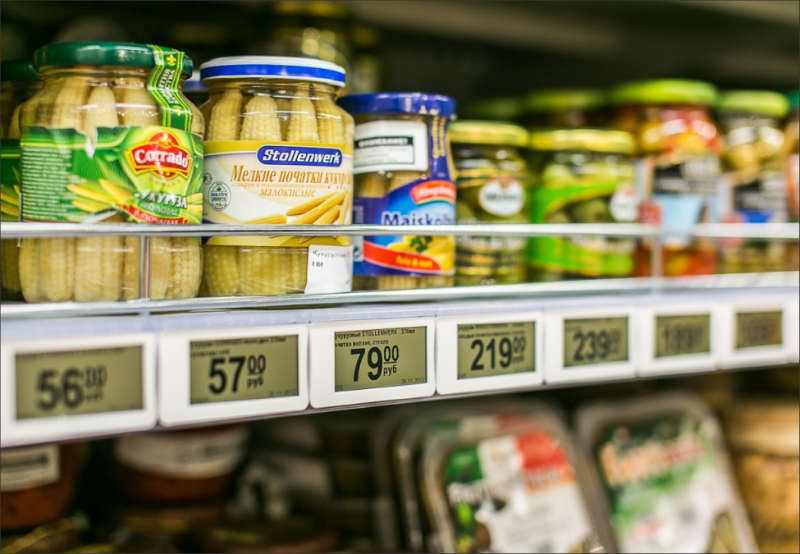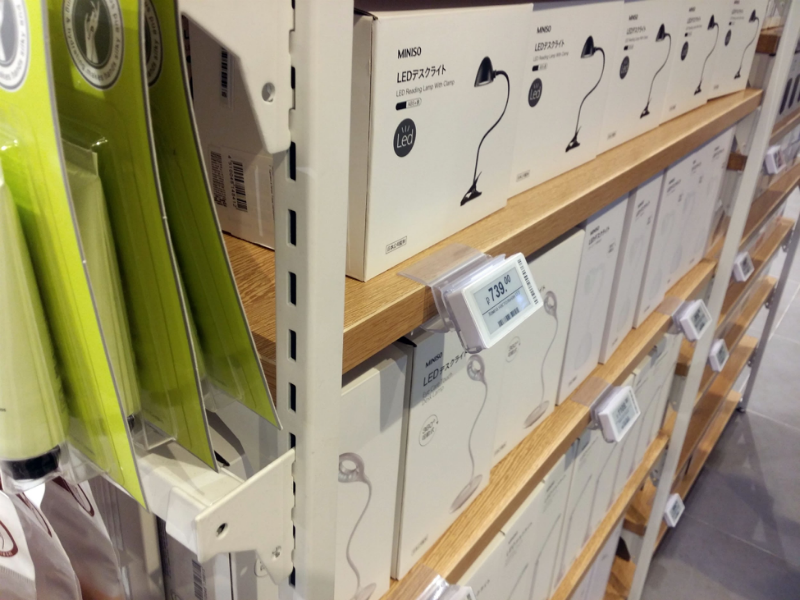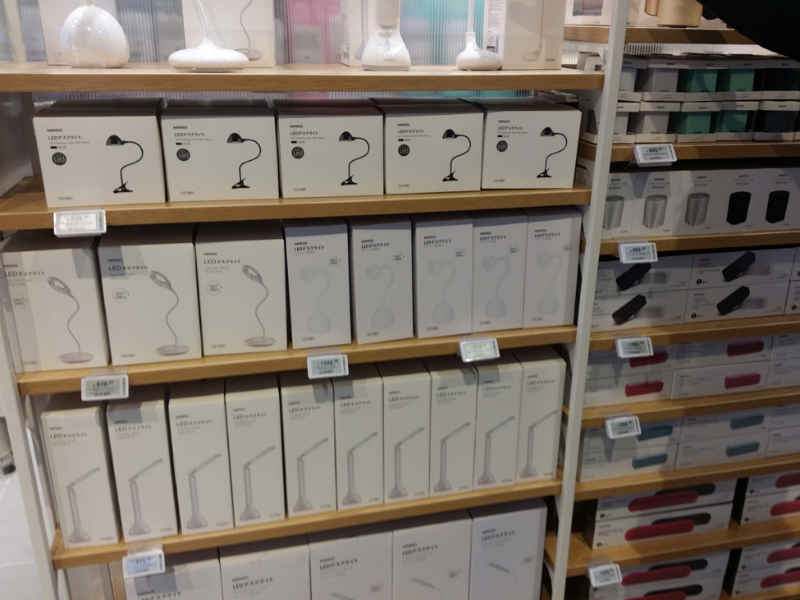How shops lure customers: electronic price tags

Progress in the retail industry is progressing rapidly. Sometimes new technologies are being introduced at the initiative of the state, which, for example, wants to know about all purchases in stores - soon they will only install online cash registers . In other cases, the stores themselves are looking for ways to attract customers.
Today we will talk about how retailers lure buyers and wage “price wars” using the technology of electronic price tags.
')
What it is
Electronic price tags (EC) are displays of various sizes that display information about the product and its price, and sometimes additional data. The technology of electronic price tags appeared abroad about 20 years ago, it is used by many large European retailers. In Russia, the process of implementing them in stores was legally simplified only in 2016, but in a short time only a few players conducted pilot system implementations and were satisfied with the results.
Currently on the market there are ECs, the screen diagonal of which is from 1.5 to 8 inches (from 3 to 20 cm). Small electronic price tags, such as 1.5-inch, most often placed directly on the shelf calculations next to the goods. Larger displays (6–8-inches) are usually mounted on a hanging eaves over a product or individual stands next to a large-sized product. There are several types of electronic price tags - infrared, with a radio channel and working on Wi-Fi.
At first glance, it seems that these digital displays do a maximum to help shops save on consumables when printing paper price tags. However, if you dig deeper, it becomes clear that this is a powerful marketing and competitive tool.
Price war
A store that uses electronic price tags can get an advantage in the fight against competitors working in the old-fashioned way using paper. In general, in the grocery retail sector, when using the second approach, it is very difficult to hold promotions often - therefore, well-known magazines and newspapers with discounted goods appear in stores no more than once a week.

At the same time, retailers actively analyze the activities of competitors, so any marketing campaigns and discounts do not go unnoticed. In the case of traditional paper price tags, it is not so easy to reduce the price of a group of goods after a competitor - at least a week will be spent on preparing new price tags in stores, as well as printing marketing materials.
When using electronic price tags you can make changes within one day. As a result, a store that repeats the steps of a nearby competitor can deprive of the benefits of the campaign and, conversely, increase its own revenues due to large sales.
In addition, when using electronic price tags, the store gets the opportunity to conduct “peak hour” actions, when the price of a product is valid only for a certain time. With paper price tags to hold such actions, in fact, is impossible, and the use of electronic allows you to easily change the price during the day and attract buyers.
As a bonus, by refusing paper price tags, the store saves on staff and supplies. Think for yourself: to change the price even for one product, you need to print new price tags, and then place them on the shelves. If we are talking about a chain of stores or the need to change the price of many goods at the same time, the task is many times more complicated.
Mobile applications: its own price for each client
More and more retailers are releasing their own mobile apps. However, they are usually not very useful for buyers - most often with their help you can only receive alerts about promotions taking place in stores. Given that stocks are rarely held in large networks more than once a week, interaction with application users is not of great use.
Electronic price tags can add more personalization to this process. Many of these devices are equipped with NFC-modules - like most smartphones (for example, this technology is widely implemented in the Hanshow price tags). So the price tag can interact with the phone, which was nearby.
For example, if an application is installed on the smartphone, the user of which participates in the loyalty program of the trading network, then when approaching the price tag he will see on the phone screen the price of the goods with his own discount. This eliminates the need to carry a plastic store cards, or call the phone number or e-mail at the checkout, to find out the final price with the application of the discount.
In addition, the interaction of the smartphone with the electronic price tag allows stores to provide opportunities for stocks to producers of goods. For example, a manufacturer of soda can offer a discount on goods to certain groups of users of an application on specific days - and they will see information about this on the electronic price tag when they are already in the store next to the desired shelf or refrigerator.
Less negative and financial loss
When using paper price tags, various errors may occur, leading to negative on the part of buyers. A common situation is that the product has one price in the cash register software, but for some reason it turned out to be different on the price tag (for example, the employee made a mistake or forgot to change it). It turns out this is already at the checkout, and if the product "made it" at a higher price, the buyer is unlikely to like it.
Finding out the reasons for the wrong price display delays the queue movement, customers remain unhappy. Moreover, by law, the store is obliged to sell the goods to the buyer at the price indicated on the price tag. That is, there may be immediate financial losses.
Paper price tags are usually not very high and it’s not easy to look at such details about the cost and discounts. As a result, it often happens that the buyer expects to receive the goods at a lower price and gets upset when he finds out that he did not get into the necessary time slot. And any residue left by the client leads to the fact that another time he will not come to this store, preferring a more loyal competitor. Electronic price tags can be much larger than paper ones; in addition, several information screens can be sequentially displayed on them, and not just static text. As a result, they are easier to consider all the details associated with the price.

What prevents the introduction of electronic price tags
Despite all these advantages, there are a number of factors that limit the spread of electronic price tags in our country. First of all, at the legislative level, their use was allowed only in the past year, so not all retailers managed to analyze the benefits of their use.
Another important point - the introduction of electronic price tags (hardware + software) is quite expensive. The equipment of a large store for 20 thousand price tags at the moment will cost about $ 400 thousand. At the same time, the prices for the elements of electronic price tag systems are constantly decreasing - more and more cheaper devices from Chinese manufacturers appear. As a result, over the past few years, the price of implementing such systems has decreased by about 20%.
As a result, now the payback period of such systems in Russia is 4-5 years, if you do not take into account the economic effect of marketing campaigns, and take into account only personnel costs and printing price tags on paper. It is often not satisfied with the business. In our country, few companies are engaged in planning for such a long time, usually the management expects to see a return on investment already "today" or at least within a year. It is important to understand that electronic price tags are needed not just as a means of displaying prices or improving the image, they should be used as a marketing tool, only then the business will get real benefits.
According to the results of pilot implementations conducted in a number of stores, already today there are data showing that installing electronic price tags allows reducing costs from using paper price tags to 30%. The growing number of successful projects together with the reduction in the cost of such systems suggests that soon more and more stores will begin to use electronic price tags.
Want to learn more about the marketing opportunities of electronic price tags that will help the retailer to increase the average bill and increase customer loyalty? Leave a request for consultation on the Pilot company website https://www.pilot.ru/catalog/elektronnye-tsenniki/ .
Source: https://habr.com/ru/post/325032/
All Articles